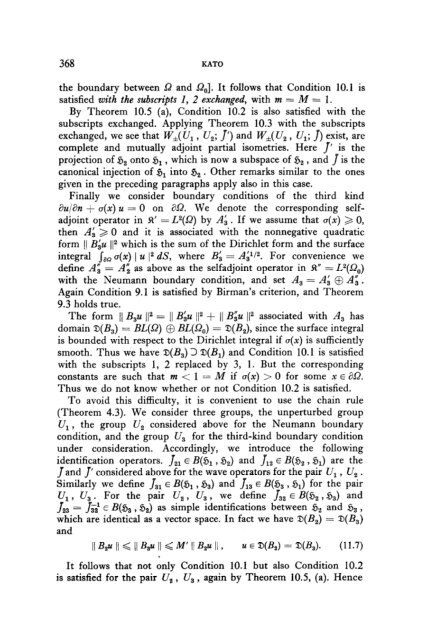On the Characters and the Plancherel Formula of Nilpotent Groups ...
On the Characters and the Plancherel Formula of Nilpotent Groups ...
On the Characters and the Plancherel Formula of Nilpotent Groups ...
Create successful ePaper yourself
Turn your PDF publications into a flip-book with our unique Google optimized e-Paper software.
368 KATO<br />
<strong>the</strong> boundary between IR <strong>and</strong> @,I. It follows that Condition<br />
satisfied with <strong>the</strong> subscripts 1, 2 exchanged, with m = M = 1.<br />
10.1 is<br />
By Theorem 10.5 (a), Condition 10.2 is also satisfied with <strong>the</strong><br />
subscripts exchanged. Applying Theorem 10.3 with <strong>the</strong> subscripts<br />
exchanged, we see that W,( U, , U,; 9’) <strong>and</strong> W,( U, , U,; 9) exist, are<br />
complete <strong>and</strong> mutually adjoint partial isometries. Here 9’ is <strong>the</strong><br />
projection <strong>of</strong> & onto $jl , which is now a subspace <strong>of</strong> J& , <strong>and</strong> p is <strong>the</strong><br />
canonical injection <strong>of</strong> $r into sjB . O<strong>the</strong>r remarks similar to <strong>the</strong> ones<br />
given in <strong>the</strong> preceding paragraphs apply also in this case.<br />
Finally we consider boundary conditions <strong>of</strong> <strong>the</strong> third kind<br />
au/&z + u(x) u = 0 on aJ2. We denote <strong>the</strong> corresponding selfadjoint<br />
operator in R’ = L2(sZ) by Ai . If we assume that o(x) > 0,<br />
<strong>the</strong>n A; > 0 <strong>and</strong> it is associated with <strong>the</strong> nonnegative quadratic<br />
form 1) Bju ]I2 which is <strong>the</strong> sum <strong>of</strong> <strong>the</strong> Dirichlet form <strong>and</strong> <strong>the</strong> surface<br />
integral Jan u(x) 1 u I2 dS, where B; = Ai1i2. For convenience we<br />
define A: = Ai as above as <strong>the</strong> selfadjoint operator in a” = L2(Q,,)<br />
with <strong>the</strong> Neumann boundary condition, <strong>and</strong> set A, = Aj @ A:.<br />
Again Condition 9.1 is satisfied by Birman’s criterion, <strong>and</strong> Theorem<br />
9.3 holds true.<br />
The form 11 B,u /I2 = 11 Bju /I2 + (I B& II2 associated with A, has<br />
domain 3(B3) = BL(Q) @ BL(Q,) = a(B,), since <strong>the</strong> surface integral<br />
is bounded with respect to <strong>the</strong> Dirichlet integral if u(x) is sufficiently<br />
smooth. Thus we have D(B,) 3 D(B,) <strong>and</strong> Condition 10.1 is satisfied<br />
with <strong>the</strong> subscripts 1, 2 replaced by 3, 1. But <strong>the</strong> corresponding<br />
constants are such that m < 1 = M if u(x) > 0 for some x E 8Q.<br />
Thus we do not know whe<strong>the</strong>r or not Condition 10.2 is satisfied.<br />
To avoid this difficulty, it is convenient to use <strong>the</strong> chain rule<br />
(Theorem 4.3). We consider three groups, <strong>the</strong> unperturbed group<br />
U, , <strong>the</strong> group U, considered above for <strong>the</strong> Neumann boundary<br />
condition, <strong>and</strong> <strong>the</strong> group U, for <strong>the</strong> third-kind boundary condition<br />
under consideration. Accordingly, we introduce <strong>the</strong> following<br />
identification operators. Jzr E B(& ,a,) <strong>and</strong> Ji2 E B(& , &) are <strong>the</strong><br />
J<strong>and</strong> J’ considered above for <strong>the</strong> wave operators for <strong>the</strong> pair U, , U, .<br />
Similarly we define Jal E B($j, , $a) <strong>and</strong> Jr, E B($& , $i) for <strong>the</strong> pair<br />
U, , U, . For <strong>the</strong> pair U, , U, , we define Ja2 E B(Jj, , a,) <strong>and</strong><br />
-723 = hi1 E W, 9 52) as simple identifications between fj, <strong>and</strong> $a ,<br />
which are identical as a vector space. In fact we have a(B,) = Ad<br />
<strong>and</strong><br />
II B,u II < II B,u II < M’ II B,u II > u E a(B,) = 3)(B,). (11.7)<br />
It follows that not only Condition 10.1 but also Condition 10.2<br />
is satisfied for <strong>the</strong> pair U, , U, , again by Theorem 10.5, (a). Hence

















